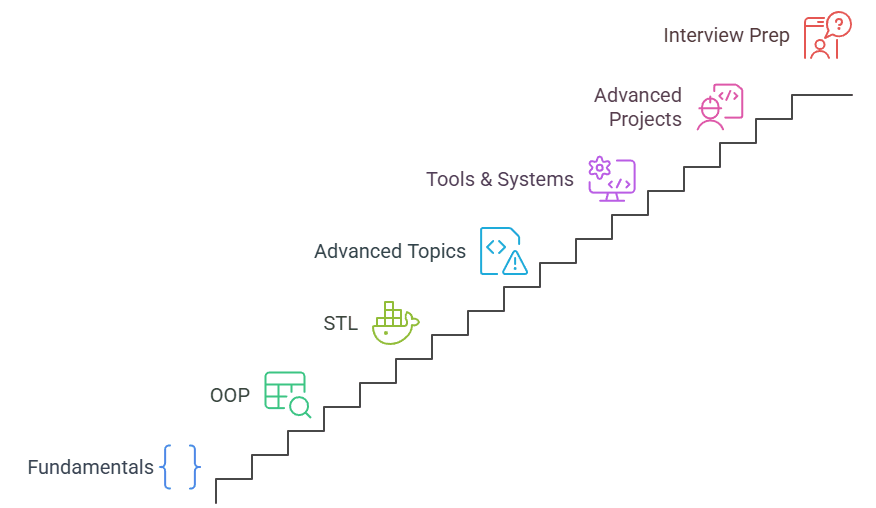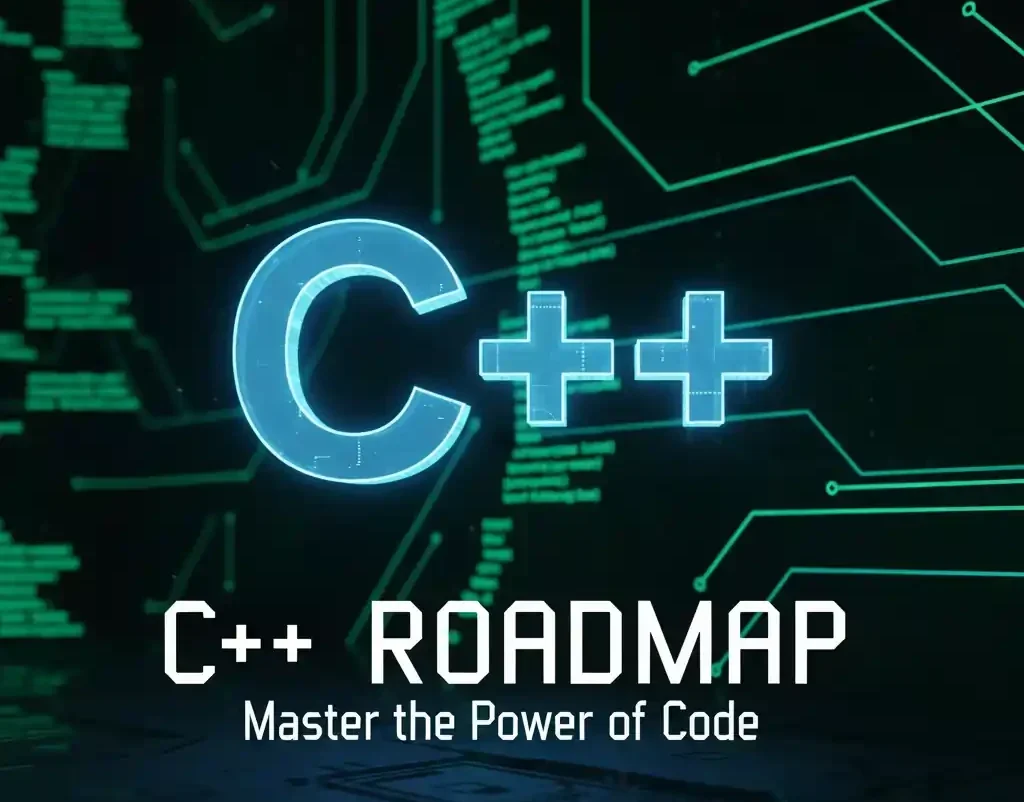Hey there, future code wizard. Ever stared at a blank screen, fingers hovering over the keyboard, wondering where on earth to start with C++? I get it, it’s like standing at the base of a mountain, backpack stuffed with tools you don’t know how to use yet. But here’s the good news: you don’t need a PhD in computer science to conquer it. I’ve walked this path myself, tripping over pointers and debugging late into the night, and came out the other side building apps that actually run (and impress bosses).
In this guide, we’re mapping out a no-fluff C++ learning roadmap that’ll take you from “What’s a variable?” to “I just optimized a game engine.” We’ll hit the essentials, sprinkle in some battle-tested tips, and even peek at real stories from devs who’ve turned their side hustles into six-figure gigs. By the end, you’ll have a clear plan, actionable steps, and the confidence to tackle any project. Let’s dive in; your first “Hello, World!” awaits.
Table of Contents
Why Bother with C++ in 2025? The Real Deal
Picture this: You’re scrolling job boards, and every high-paying gig screams “C++ experience preferred.” It’s not hype. C++ powers everything from the engines in your favorite video games (think Unreal Engine) to the software keeping Wall Street humming. According to the TIOBE Index, C++ consistently ranks in the top three languages, holding steady at around 10% of developer usage worldwide. That’s billions of lines of code running on everything from your phone’s OS to NASA’s Mars rovers.
But it’s not just about jobs, though, yeah, median salaries hover around $120K for C++ devs in the US. Learning C++ sharpens your brain like nothing else. It forces you to think low-level: memory management, performance tweaks, the works. One study from Stack Overflow’s 2023 survey showed that 70% of professional developers credit C++ for making them better coders overall, no matter the language.
The catch? It’s got a rep for being “hard.” And sure, it can bite if you ignore best practices, like that time I segfaulted an entire simulation because of a dangling pointer. But with the right roadmap, it’s rewarding as hell. Ready to flip the script?
Prerequisites: Gear Up Before You Code
Before we charge ahead, let’s make sure you’re set. No, you don’t need a fancy CS degree. Most folks start with just curiosity and a laptop.
- Basic Programming Comfort: If you’ve tinkered with Python or JavaScript, great. If not, spend a weekend on freeCodeCamp’s intro to programming. It builds that “aha” moment without the overwhelm.
- Hardware Setup: Grab a decent machine, 8GB RAM minimum, but 16GB if you’re eyeing game dev. Install a code editor like Visual Studio Code (free, lightweight) or CLion for the pros.
- Compiler Basics: Download GCC via MinGW on Windows or just use the built-in on macOS/Linux. Test it with a simple compile: g++ hello.cpp -o hello && ./hello. Boom, you’re compiling.
Pro tip: Set up Git right away. Version control isn’t optional; it’s your safety net. One dev I know lost a week’s work to a hard drive crash; never again.
With that sorted, let’s hit the road.

Step 1: Nail the Fundamentals (Weeks 1-4)
Start here, or you’ll build on sand. This beginner C++ tutorial phase is about getting comfy with the syntax that makes C++ tick. Think of it as learning the alphabet before writing novels.
Key concepts to master:
- Variables and Data Types: Integers, floats, strings, booleans. Remember, C++ is typed; int x = 5; isn’t optional. Fun fact: Mismatching types causes 40% of newbie errors, per GitHub’s bug reports.
- Operators and Control Flow: If-else, loops (for, while), switch statements. Practice by writing a simple calculator app.
- Functions: Define reusable code blocks. Pass by value vs. reference? Crucial for efficiency.
Actionable tip: Code daily for 30 minutes. Use online compilers like Replit to skip setup headaches. By week 2, build a number-guessing game, input validation included. It’ll teach error handling without the tears.
Real-world example: Sarah, a career-switcher from marketing, started here. Four weeks in, she had a console-based to-do list app. “It felt clunky,” she says, “but seeing it work? Addictive.”
Aim for 80% code, 20% reading. Books like “C++ Primer” (Lippman) are gold, skip the fluff, focus on chapters 1-5.
Step 2: Dive into Object-Oriented Programming (Weeks 5-8)
C++ shines in OOP; it’s what turns spaghetti code into elegant structures. This step bridges beginner C++ tutorial vibes to real power.
Core topics:
- Classes and Objects: Encapsulation is your friend. Create a Car class with speed and accelerate() methods.
- Inheritance and Polymorphism: Base classes, derived ones, virtual functions. Why? Reusability saves hours.
- Constructors/Destructors: Manage memory like a boss. RAII (Resource Acquisition Is Initialization) is a game-changer.
Stats to chew on: OOP reduces code duplication by up to 50%, according to a Carnegie Mellon study on software engineering.
Tip: Draw UML diagrams on paper first. Tools like draw.io are free. Then code it up. Challenge: Build a library management system with Book and User classes.
Case study: Mike, a robotics hobbyist, used this to prototype a drone controller. “Inheritance let me extend sensor classes without rewriting everything,” he shared in a Reddit AMA. Result? His project won a local hackathon, landing him an internship at a defense firm.
Don’t rush; test with unit frameworks like Google Test early. Bugs in OOP are sneaky.
Step 3: Conquer the Standard Template Library (STL) (Weeks 9-12)
STL is C++’s secret sauce, pre-built tools that save you from reinventing the wheel. Ignore it, and you’re coding like it’s 1995.
Must-knows:
- Containers: Vectors for dynamic arrays, maps for key-value pairs, sets for uniqueness.
- Algorithms: Sort, find, transform. <algorithm> header is your playground.
- Iterators: Traverse collections like a pro.
Fact: STL boosts productivity by 30-40%, according to a JetBrains survey of C++ devs.
Practical hack: Replace arrays with vectors everywhere. In a sorting project, time a bubble sort vs. std::sort, what is the difference? Jaw-dropping.
Example: For a contact book app, use std::map<std::string, std::vector<Contact>>. Add search with std::find. Deploy it as a CLI tool; share on GitHub for feedback.
By now, your code’s cleaner and faster. Celebrate with coffee, you earned it.
Step 4: Tackle Advanced Topics (Months 4-6)
Welcome to the deep end. This is where C++ best practices separate hobbyists from pros. Focus on what makes code scalable and safe.
Big hitters:
- Templates and Generics: Write once, use anywhere. template<typename T> void swap(T& a, T& b) magic.
- Exception Handling: Try-catch blocks prevent crashes. Log errors with std::cerr.
- Smart Pointers: std::unique_ptr and std::shared_ptr banish memory leaks. Manual delete? So 2005.
Insight: Memory bugs cause 70% of security vulnerabilities in C++ apps, says Microsoft’s security team. Smart pointers fix that.
Tip: Profile with Valgrind (free tool) to hunt leaks. Start small: Refactor your library app to use templates for generic search.
Real story: Elena, a fintech dev, mastered exceptions during a trading platform build. “One unhandled divide-by-zero could’ve cost thousands,” she recalls. Her fix? Robust error propagation. Now she’s leading a team at a startup valued at $50M.
Pair this with multithreading basics, std::thread for concurrency. But thread carefully; race conditions are evil.
Step 5: Tools and Build Systems (Months 7-8)
Code’s worthless without tools. This step polishes your workflow, aligning with C++ best practices for teams.
Essentials:
- CMake: Cross-platform builds. Write a CMakeLists.txt for your projects.
- Debuggers: GDB or VS Code’s built-in. Set breakpoints, watch variables.
- Version Control Deep Dive: Git branches, merges, CI/CD with GitHub Actions.
Stat: Teams using CMake deploy 25% faster, per a Linux Foundation report.
Hack: Automate testing. Integrate Catch2 for quick unit tests. Push to GitHub, now you’ve got a portfolio piece.
Example: Tom’s first CMake setup was for a file parser. “It felt overkill for 200 lines,” he laughed, “but scaling to 10K? Lifesaver.” His repo caught a recruiter’s eye, snagging a remote gig.
Step 6: Build Advanced C++ Projects (Months 9-12)
Theory’s cool, but projects prove you can ship. Time for advanced C++ projects that scream “hire me.”
Ideas to ignite:
- Chat Server: Use sockets (<sys/socket.h>) and threads. Handle 10+ clients.
- Ray Tracer: Graphics with STL and math libs. Render a bouncing ball, visual wow factor.
- Game Engine Mini: Tic-tac-toe with SFML library for graphics.
Tip: Start with pseudocode. Allocate time: 40% planning, 40% coding, 20% polishing. Document with READMEs.
Case study: Javier built a stock analyzer using multithreading for real-time data. Pulled APIs via libcurl. “It processed 1M records in seconds,” he says. Posted on LinkedIn, boom, interviews at quant firms. Salary jump: 40%.
Track progress in a journal. Stuck? Stack Overflow’s your friend, but explain your attempts first.
Step 7: Prep for the Real World with C++ Interview Questions (Month 13+)
You’ve got skills, now flaunt ’em. Interviews test depth, so weave in C++ interview questions practice.
Common curveballs:
- “Explain virtual destructors.” (Polymorphism cleanup.)
- “Big Three/Five Rule.” (Copy/move constructors for resource management.)
- “When to use const?” (Immutability for safety.)
Fact: 60% of C++ interviews include live coding, per LeetCode data. Practice on HackerRank.
Strategy: Mock interviews on Pramp. Record yourself, fix those “ums.”
Success story: Lisa, post-roadmap, aced a Google interview. “The roadmap’s project emphasis made behavioral questions easy,” she emailed me. “I talked through my ray tracer like a boss.” Offer: $150K base.
Wrapping It Up: Your Journey Starts Now
There you have it, your ultimate C++ learning roadmap, distilled from years of trial, error, and triumph. Seven steps, from fumbling basics to crushing interviews. Remember, consistency trumps intensity. Code a little every day, build something useful, and share your wins (or woes) in communities like r/cpp.
You’ve got the map; the terrain’s yours to conquer. What’s your first project? Drop it in the comments, I’d love to hear. Now go forth and code like the beast you are.
FAQs
How long does it take to complete a full C++ learning roadmap as a complete beginner?
It varies, but with 10-15 hours weekly, expect 12-18 months to go from zero to job-ready. Factors like prior coding help speed it up; many hit intermediate in 6 months. Track milestones, not calendar days.
What are the best free resources for a beginner C++ tutorial online?
Start with cppreference.com for syntax dives, then The Cherno’s YouTube series for visual walkthroughs. Pair with Exercism.io for guided exercises. Avoid paid courses until the basics click.
Can advanced C++ projects help land a software engineering job?
Absolutely, recruiters love tangible proof. A GitHub repo with 3-5 polished projects (like a networked game) can boost callbacks by 50%, based on LinkedIn hiring trends. Focus on clean code and READMEs.
What C++ best practices should I adopt early to avoid common pitfalls?
Always use const where possible, prefer smart pointers over raw ones, and write tests from day one. Lint with clang-tidy. These cut debugging time in half, per dev surveys.
How do I prepare for C++ interview questions on multithreading and STL?
Practice with LeetCode’s C++ tagged problems, focusing on std::mutex for threads and std::unordered_map efficiency. Explain trade-offs aloud, interviewers want reasoning, not rote answers.


















